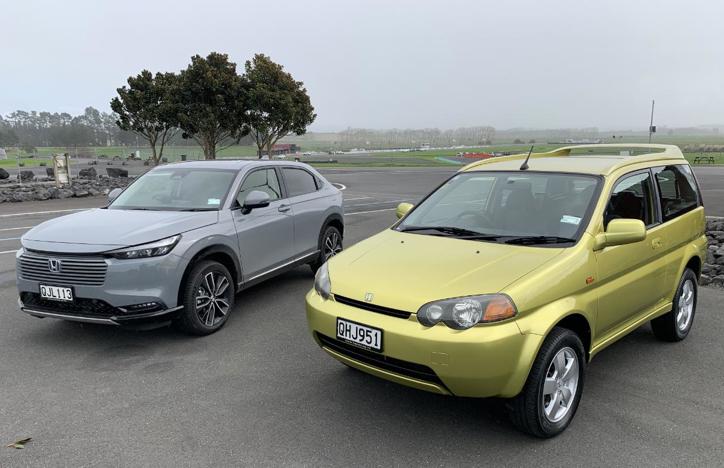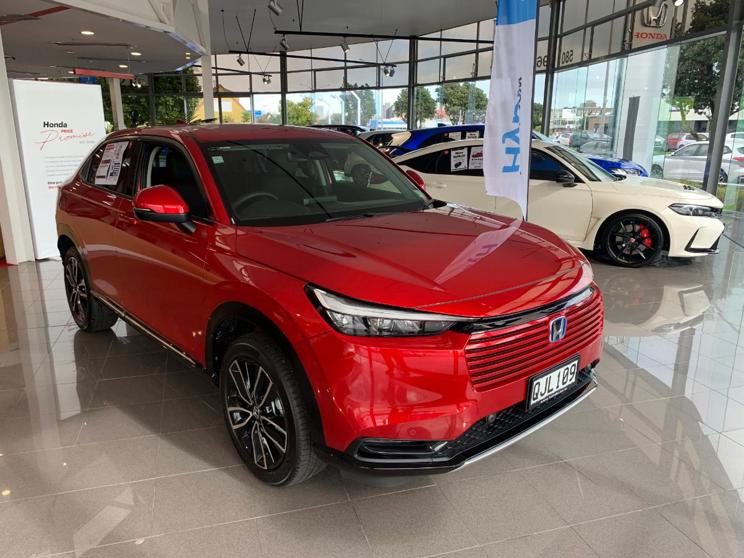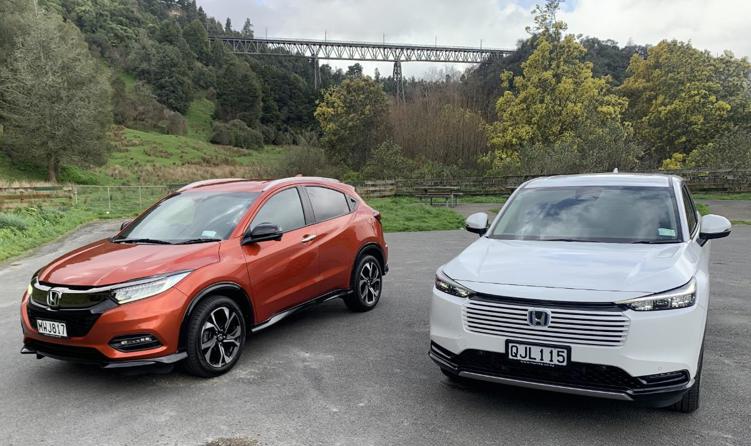Honda New Zealand may have had a two-year hiatus from the HR-V being in its line-up, but it’s back with a facelift, and better: bigger inside, now running a hybrid 1.5-litre petrol engine, and even a few new comforting innovations that make the new model a big step up from the previous.

Following its local NZ launch in 1999, the third generation marks the quarter-century of HR-V, and as Honda’s sub compact and smallest SUV, we had to wait for the facelift due to technical/mechanical issues with the first-gen.

But it’s been well worth the wait as this HR-V is packed with a lot of the technology, space and equipment found in the recently introduced, updated and larger ZR-V and CR-V siblings.
Most noticeable and identifiable is that grille, especially in lighter/whiter colours: the A/C vent look is distinctive, and a little EV-like, though there is a $1250 optional, more conventional grille, if it’s not you.

At $45,800, it’s not that far under it HR-V, just $1200 in base-models, the HR-V does only come in one model, which uses the 1.5-litre normally aspirated petrol engine with Honda’s e:HEV hybrid technology.
We’ve covered this engine many times before, in Jazz, ZR-V and CR-V, and it’s a very clever, very complex but quite logical way to do hybrid, different to the like of Toyota or Nissan, but having the ability to run as either an EV, petrol engine, or both at various times.

As a driver, it’s all mostly black magic, with the engine and electrics doing their things in partnership, and all a driver does is look at the fuel figures – which are good: 4.3l/100km is the claim. Though we saw it range between 5-6l/100km, ours was on the enthusiastic driving (and driven) roads between Palmerston North and Auckland region, where Honda launched the HR-V this week.

Performance is capable: we hand-timed 0-100km/h in 9.5 seconds, which is fine for the city SUV market the HR-V is designed for, and when the engine and motor are working together, it’s a combination of engine thrumming away, two electric motors helping and Honda’s e-CVT gearbox doing an impressive job of mimicking a conventional auto with gears, while making the most of 1.5 litres of engine.

There are three modes for driving – Econ, Normal and Sport – which does alter the way the engine and electric motor work together, but it’s all rather subtle, and we had no qualms about leaving it in Normal, and let the computer chips decide what’s best.

This is where the added sound deadening is quite noticeable: the engine is audibly working, but it’s substantially more distant and refined than the previous model, thanks to new acoustic glass and sound-suppressing foam, which we were able to compare back-to-back to the previous model along for the drive.
The other huge improvement is to suspension, with ride and handling on another level with new HR-V, offering better body control, a better ride quality over rough patches from softer springs and noticeably better noise, vibration and harshness control throughout; a deserving gold stamp for most improved suspension.

A silver star also goes to rear seat room: while the front is well equipped and comfortable, the rear seat used Honda’s Magic Seat system, able to fold flat, flip up or modulate in tall or long mode, to accommodate everything from tall plants (by flipping up the bench) to surfboards (by folding the front passenger seat flat).

For normal passengering, its comfort levels are comparable to CR-V, with 35mm more knee and foot room, enough for two six-footers to sit aligned, with the rear backrest tilted back 2 degrees – which feels perfect. Headroom is plenty, and the centre armrest, rear air vents and two touch-lights should not be taken for granted, as they are missing in many sub-compact SUVs. It is, however, a four-seater, due to the star-rating effect of the middle seat-belt that’s been removed.

The 60:40 folding rear seats and boot/rear seat packaging is also helped by the fuel tank that’s unconventionally oriented front-to-rear.

More simple and more clean is the philosophy used throughout, and the interior is reflected in this: horizontal lines that run from doors to dash along with a simple design, maximizing the largely unhindered panoramic field of view (hidden wipers for example), plus quality soft-feel, high quality materials that fit a class above itself and tech all just work: a touchscreen, wireless Apple CarPlay (Android is still wired), and sensible, loveable dials for heater/AC controls and volume all add up to a very easy interior to use and like. That is, except from the OK button that needs to be pressed on the 9-inch touchscreen every single time for every single start-up drive.

The dash is clean and covers the basics, but a home screen operated by the button on the steering wheel reveals the deeper menus, such as the charge/power and EV energy flow, fuel economy, trip computer and more. Oddly missing is an always-on bar graph that shows whether the battery is being used or charged, which allows the driver to tailor their throttle input to suit and maximise economy. Most hybrids have it, but it’s a curious omission from the home screen of HR-V – though prominent on those sub-gauges.
The only other key missing tech is a wireless smartphone charger, though Honda says this is an accessory, for $750: an odd omission, though the handy phone storage is begging for it.

While the body is a fraction narrower, you wouldn’t know it from inside, and it’s both longer and taller than previous, and sleek styled, with a slightly sloping rear, and horizontal lines and LED lights to accentuate its length and width.
Honda Sensing is new for HR-V with a wide front-view camera for seeing cars and people and the edge of the road, sonar parking sensors front and rear, adaptive cruise control with low-speed follow, collision mitigation is almost every way, from front fender-benders to reverse parking in our out of a space. There’s also traffic sign recognition, active cornering lights, and auto high-beam, once used to the fact that the blue dash light merely means it’s working, rather than dazzling oncoming drivers, a mildly confusing aspect also seen in CR-V.
On the topic of safety, officially the 2022/2024 (same car) HR-V is four-star NCAP rated, lacking some driver monitoring systems - though in our subjective opinion, this is no bad thing.

A seemingly gimmicky but rather quite practical new addition is an Air Diffusion system for the two front outer vents. Rather than a stream of cool air freezing the hands or face, a diffusion dial sends the air through a side vent, that redirects it more to the rear seats and and diffuses the flow for a softer effect.
The rear power tailgate offers a hands-free kick-to-open function, and a new hanging cargo cover works well, providing privacy and simple practicality: if the boot is overloaded, the cover simply pops from its snaps.

There’s also Honda Connect, a smartphone app that can view and adjust climate control, lights, locking and even establish a geo-fence or a speed alert when it’s driven by others (young drivers).
And all this wrapped up in Honda’s entry level SUV HR-V. Like a friend who’s been away for two tears, it’s now back in the family, and we’re better for it.
BREAK IT DOWN
Honda HR-V
ENGINE: 1.5-litre petrol Atkinson cycle four-cylinder, hybrid with two electric motors
POWER: 78kW/127Nm (96kW/253Nm combined)
BATTERY: 1.1kWh
GEARBOX: E-CVT with steps
ECONOMY: 4.3l/100km 3P-WLTP
0-100KM/H: 9.5 secs (tested)
PRICE: $45,800























